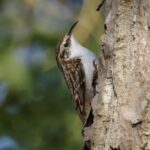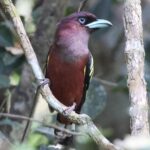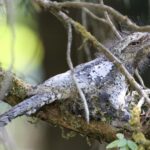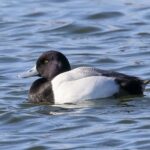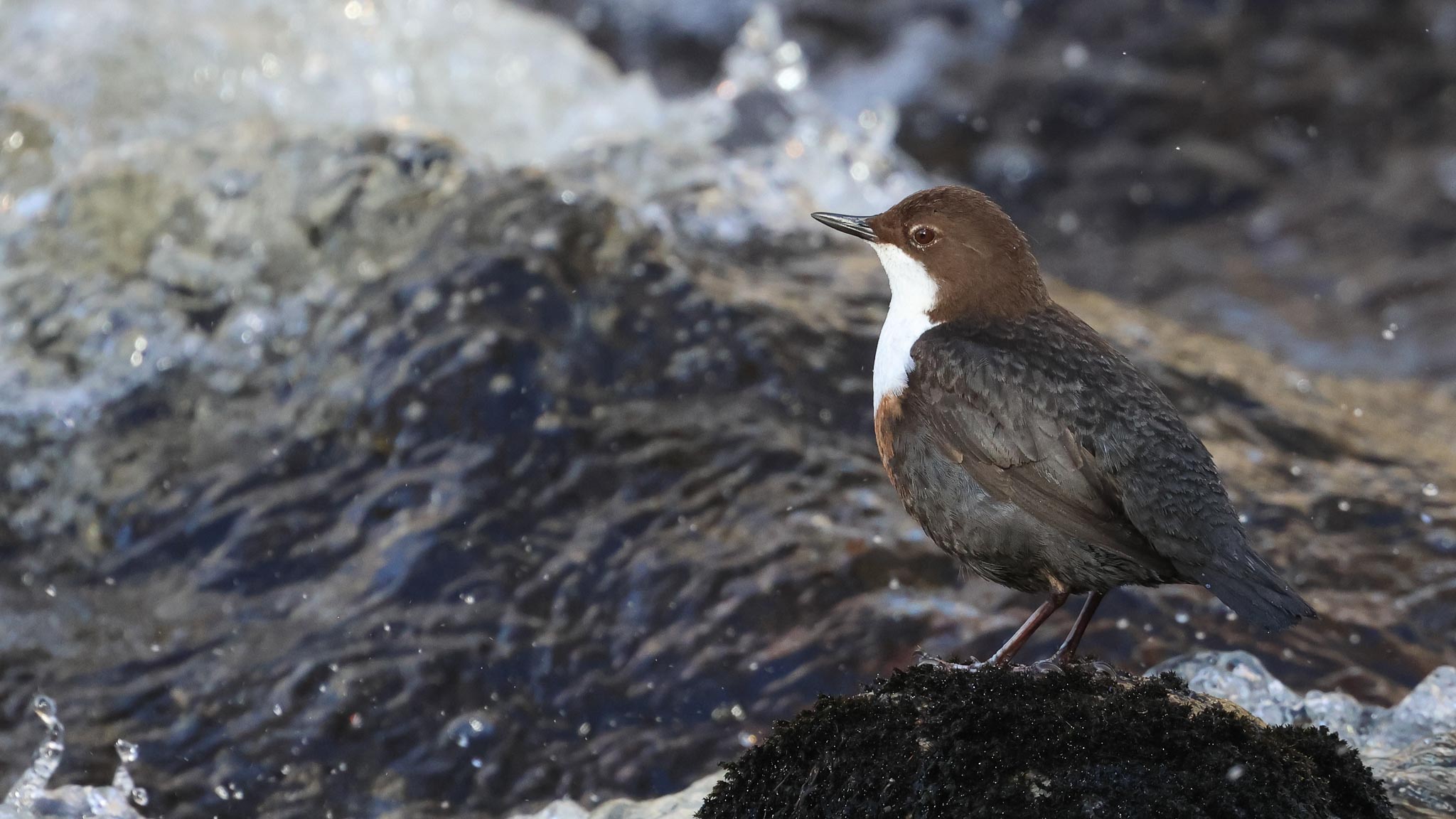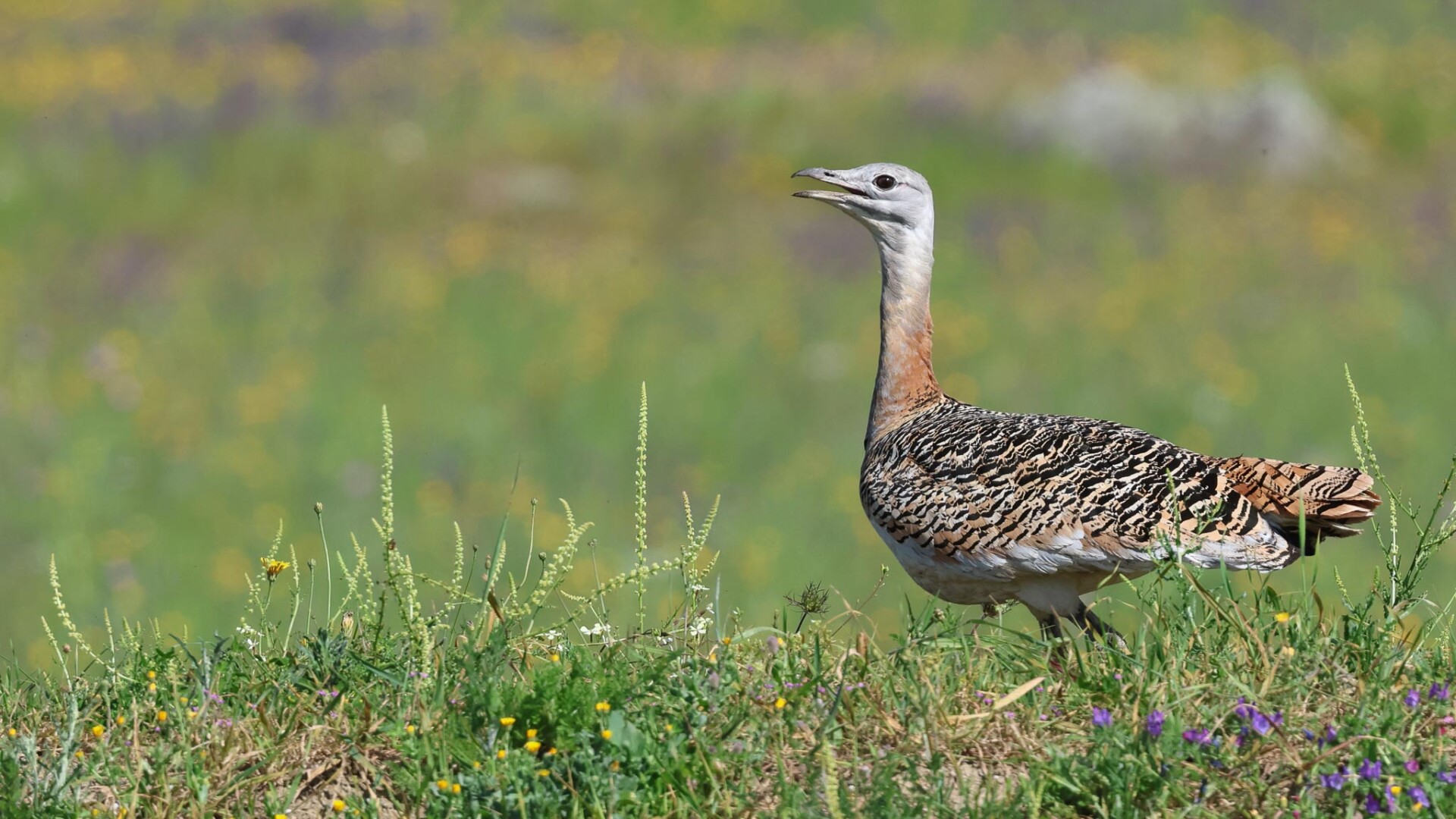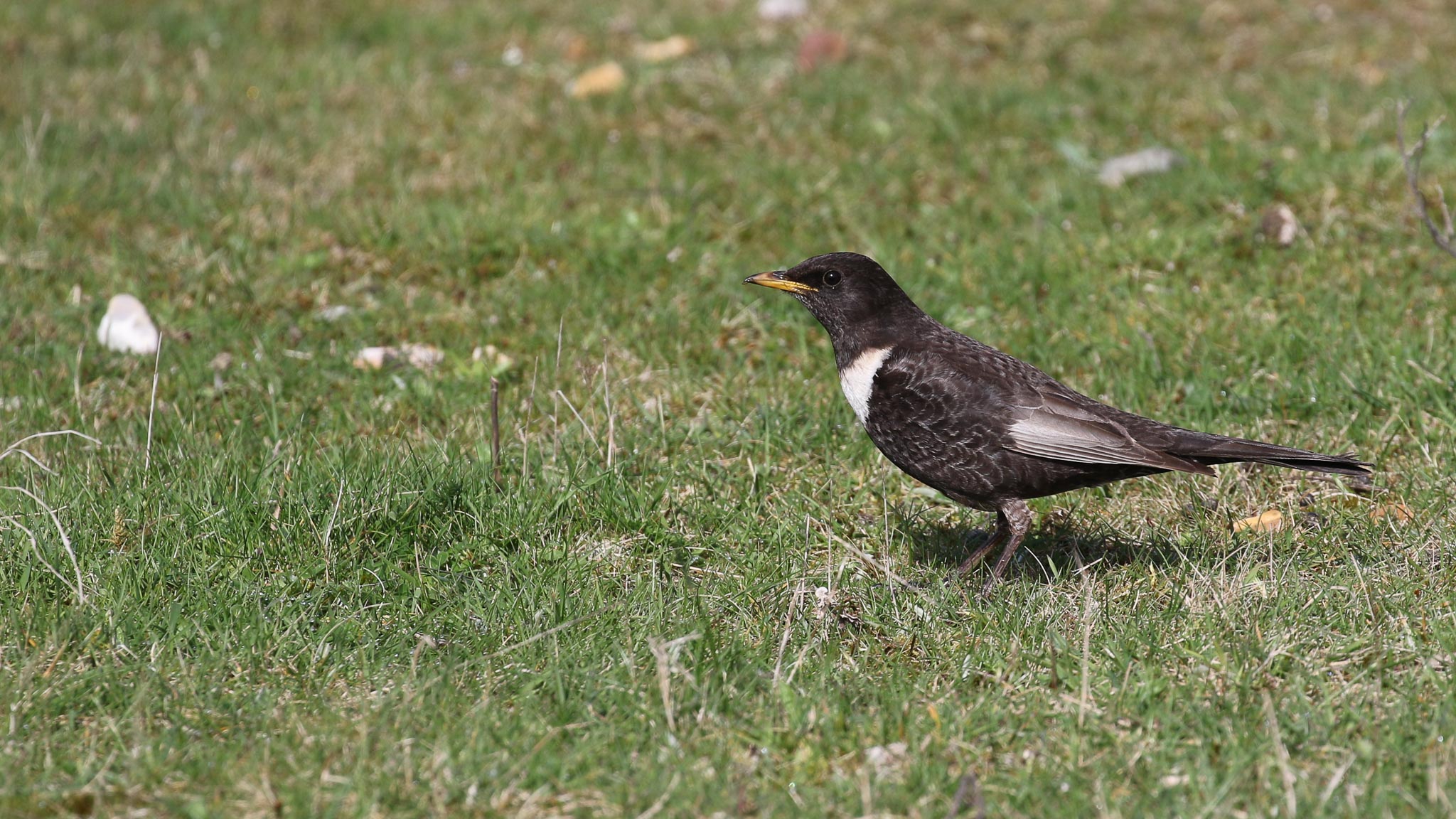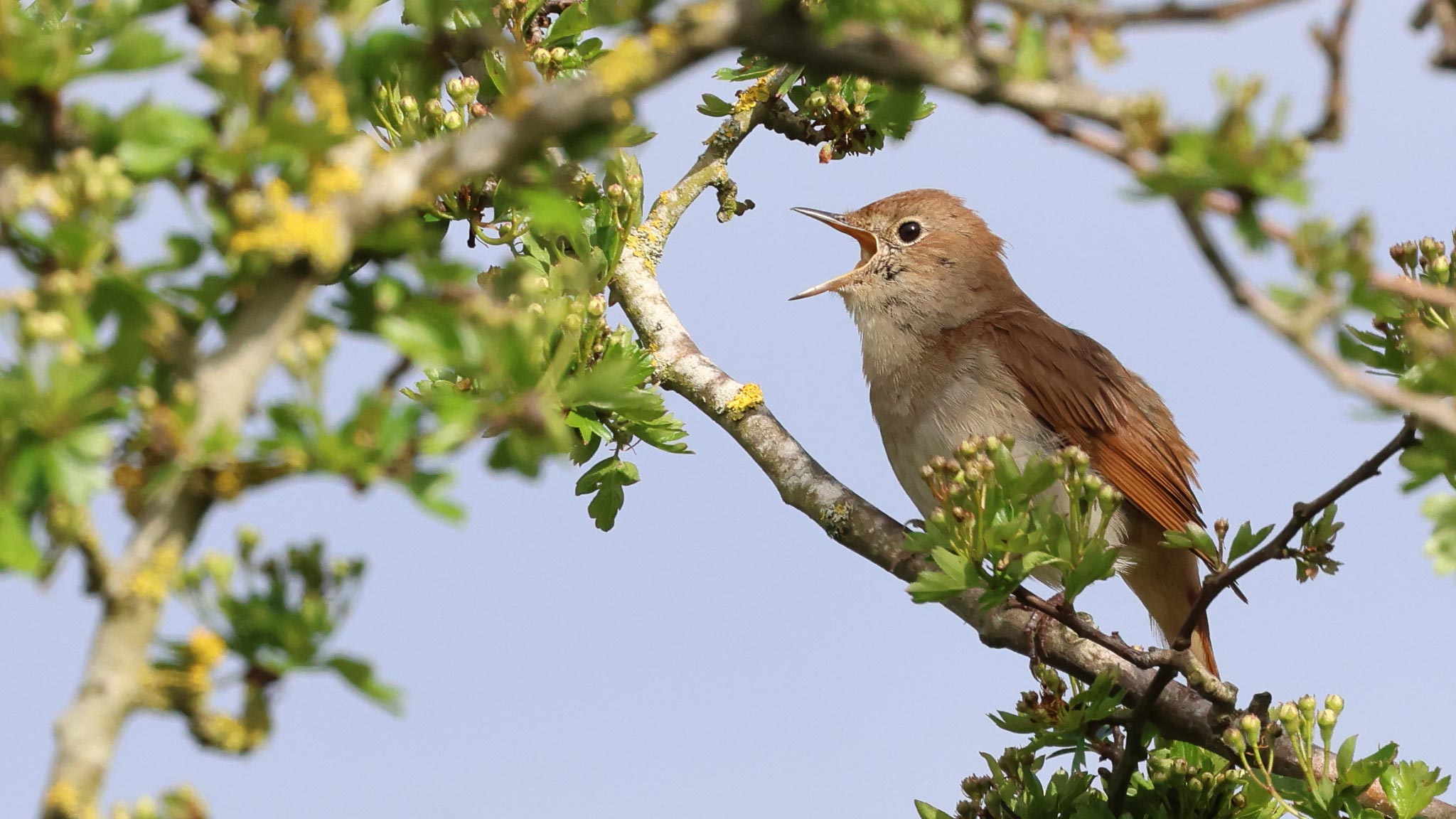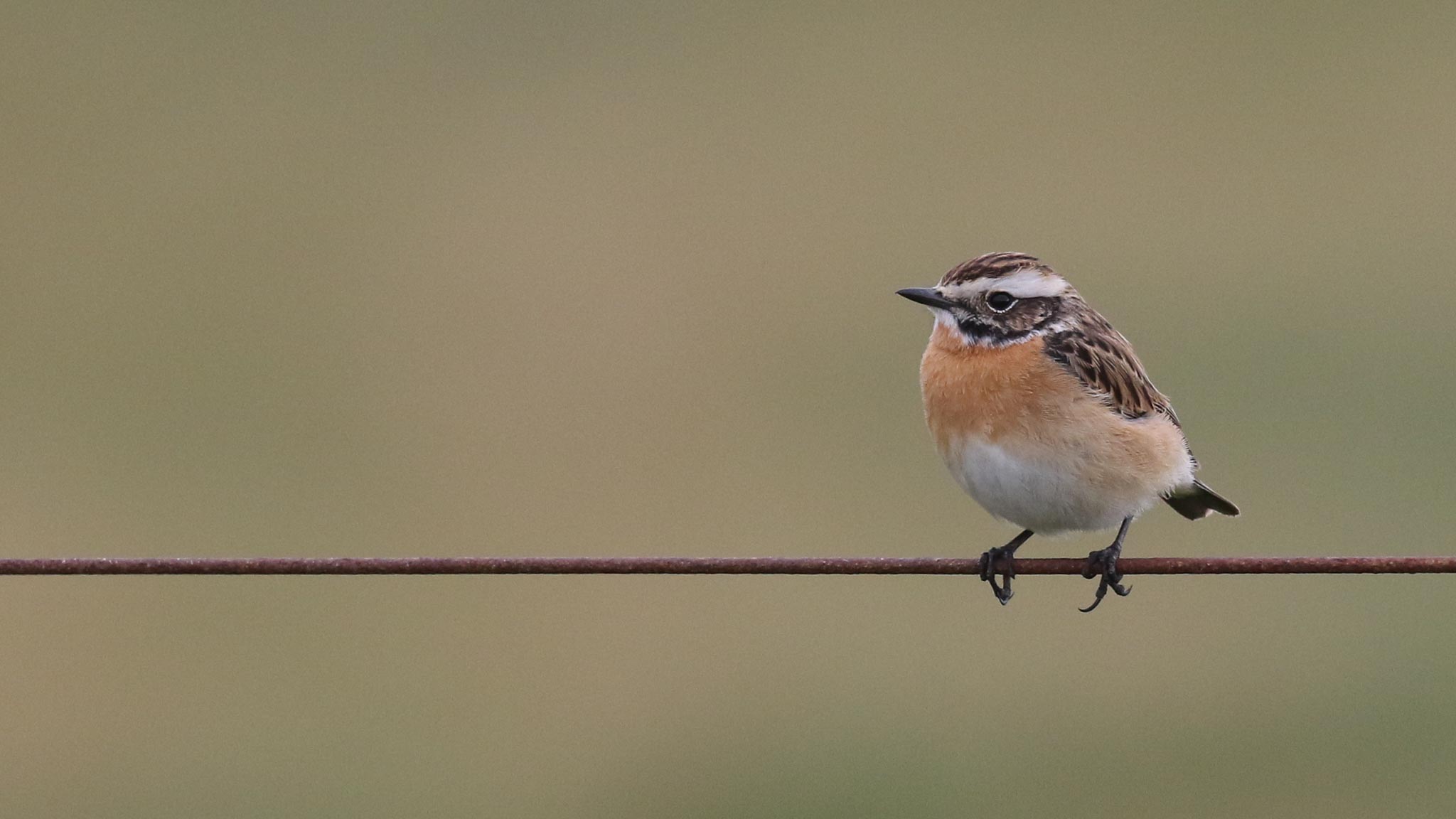A Wader Spectacular tour today. It was an early start, to get up to the Wash in time for the high tide, but it is always well worth it. The weather was kind to us as well, after all the recent rain, with patchy cloud and even some sunny intervals in the morning, and only a couple of brief light showers in the afternoon.
On our way to Snettisham, we stopped to look at a line of pigeons perched on some wires. Amongst the larger, fatter Woodpigeons were several smaller doves. A quick scan through revealed that, as well as a couple of the ubiquitous Collared Doves, there were two more delicate Turtle Doves. We could just make out their rusty scalloped upperparts as they sat preening in the morning light.
 Turtle Dove – small & delicately built compared to the nearby Woodpigeon
Turtle Dove – small & delicately built compared to the nearby Woodpigeon
Even before we got to the seawall at Snettisham, we could see a huge flock of waders take to the air. From the edge of the Wash we could see a vast cloud whirling around over the water in the distance. Something had obviously just flushed them. They settled again but further away. No problem today – the tide was going to be a high one and they would eventually be forced back towards us.
There were still little groups of Dunlin and Ringed Plovers feeding on the closest mud by the seawall. Scanning through them, we found our first Little Stint of the day. Smaller and shorter-billed than the Dunlin, the Little Stint was also clearly much brighter white below, lacking the Dunlin‘s dark belly markings. We got a good look at it but it was hard to get the scope onto it, as the birds were feeding fast, moving rapidly ahead of the fast rising tide.
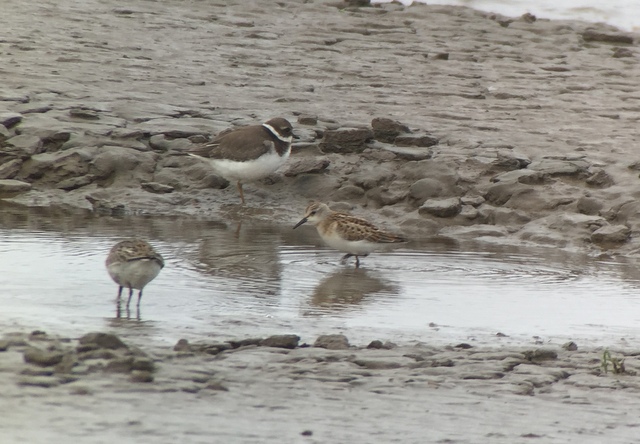 Little Stint – our first of the day, with Dunlin and Ringed Plover on the mud
Little Stint – our first of the day, with Dunlin and Ringed Plover on the mud
The Oystercatchers had not been so easily spooked as the other waders and were still gathered together on the mud from the seawall. As the tide rose, we could see the flock shuffling, the birds moving across the mud ahead of the incoming water. It was amazing to watch, the Oystercatchers all appearing synchronised so the flock appeared to flow across the mud.
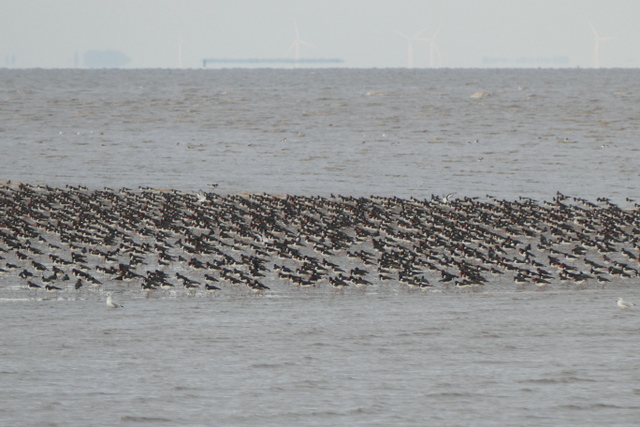 Oystercatchers – still packed in a tight flock out from the seawall
Oystercatchers – still packed in a tight flock out from the seawall
They clearly knew what was coming because, even before the tide got too high, the Oystercatchers started to take off and fly over the bank in front of us and onto the old gravel pits. We watched them peel off in large groups and drop down again the other side.

 Oystercatchers – some of the first waders to fly over to the pits
Oystercatchers – some of the first waders to fly over to the pits
With the sun rising behind us, between breaking clouds, it made for a stunning backdrop against which to watch the birds all flying inland.
 Oystercatchers – amongst the broken clouds
Oystercatchers – amongst the broken clouds
As the tide rose ever higher, the amount of exposed mud became ever smaller. Many of the waders are very reluctant to leave and so the birds squeezed themselves into the decreasing space. The flocks of Knot and Bar-tailed Godwit which had gone out across the Wash returned and joined the ever growing throng.
 Waders – concentrated onto the ever smaller area of exposed mud
Waders – concentrated onto the ever smaller area of exposed mud
Eventually, the birds were forced into the air. Small groups were peeling off all the time and flying overhead, in to the pits to roost over the high tide. Finally, the whole flock took off, thousands upon thousands, tens of thousands of birds, all in the air at once. They came over the top of us – amazing to hear the sound of all those wings beating. A truly stunning sight.

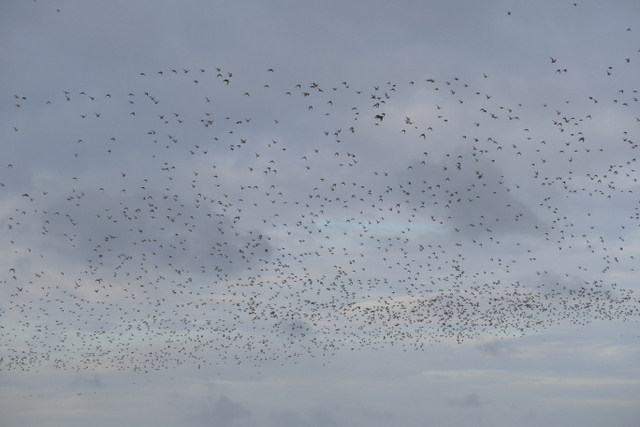


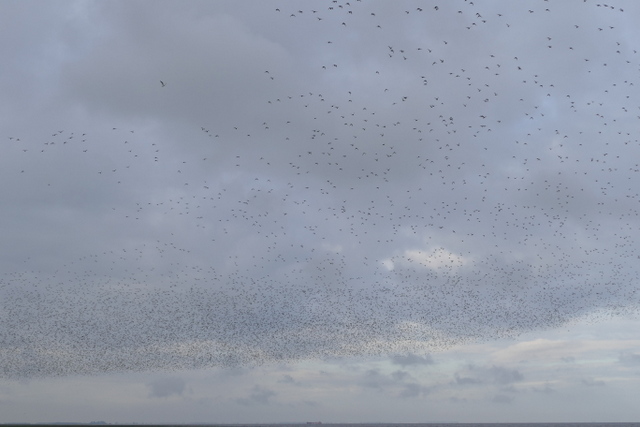
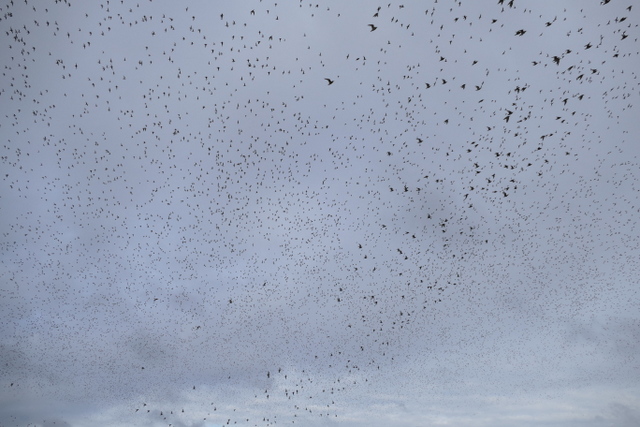 Waders – finally the whole flock took to the air and flew overhead
Waders – finally the whole flock took to the air and flew overhead
Once the mud had been pretty much emptied by this vast eruption of birds, we headed for the hides which overlook the pits. Many of the birds headed inland to roost on the fields, but there were still some huge groups of birds packed onto the islands. This is where they roost over the high tide, before they can get back out to the Wash and resume feeding once the water drops again.
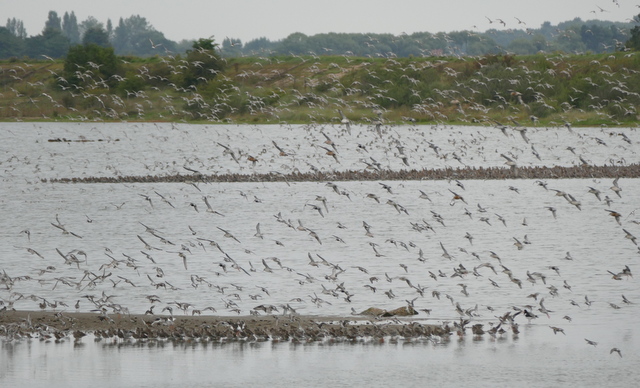 The waders left the Wash to roost on islands on the old gravel pits
The waders left the Wash to roost on islands on the old gravel pits
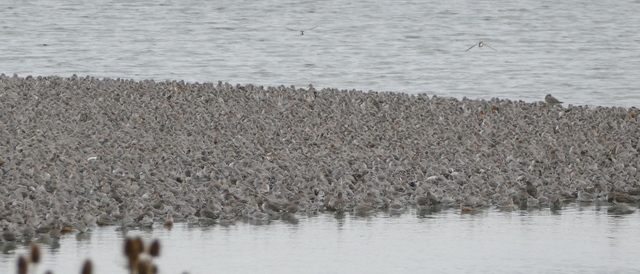 Knot – here a huge flock is packed tightly onto one small island
Knot – here a huge flock is packed tightly onto one small island
While the birds spend a lot of time sleeping, they are easily spooked into taking flight again. Many times today huge flocks burst up from where they were roosting and whirled round over the pits in tightly packed groups, before landing back down on the islands.
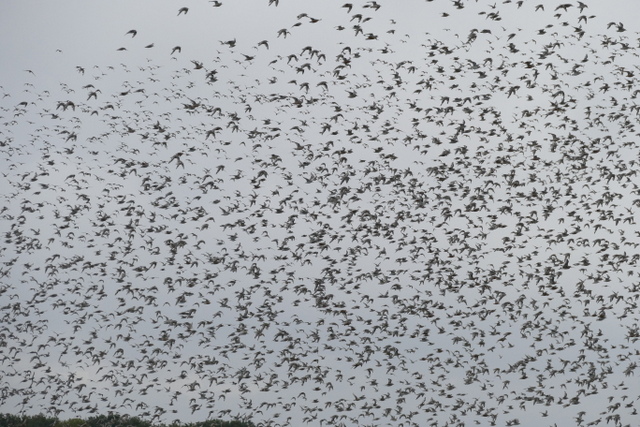
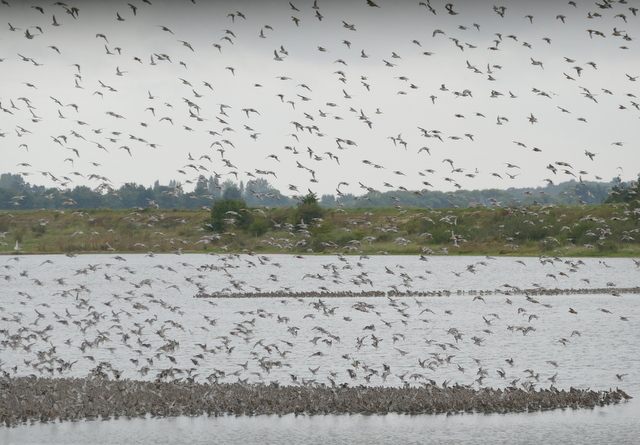 The waders whirled round over the pits and landed back on the islands
The waders whirled round over the pits and landed back on the islands
Sometimes, when the flocks were spooked into flight, small groups would fly back out towards the Wash, quickly returning once they realised that the water had not yet receded enough to expose the mud. Eventually, about an hour or so after high water, the mud started to reappear. As it did so, the birds started flying back out from the pits. They came in a series of waves – some of the larger birds, Oystercatchers, Curlews and Bar-tailed Godwits, settling first. Then the vast hordes of Knot poured out from the pits – another amazing sight.

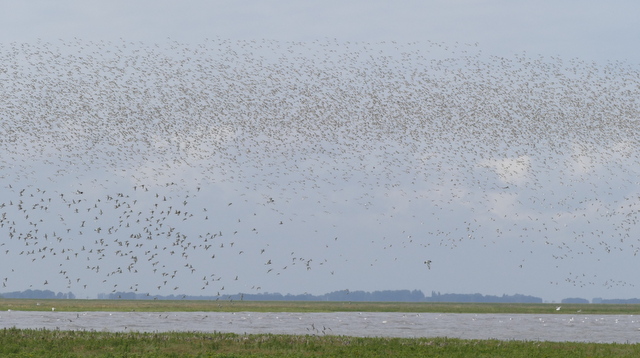
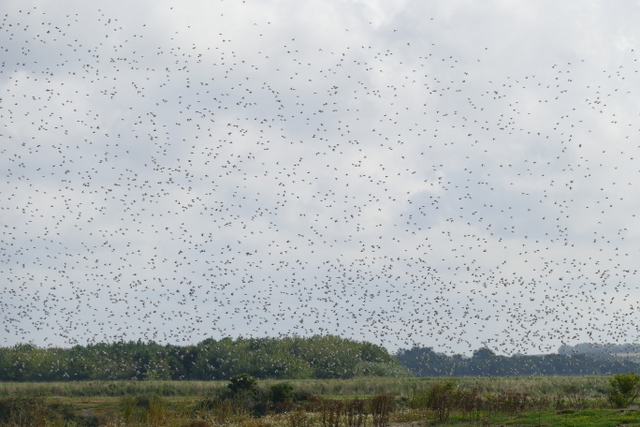
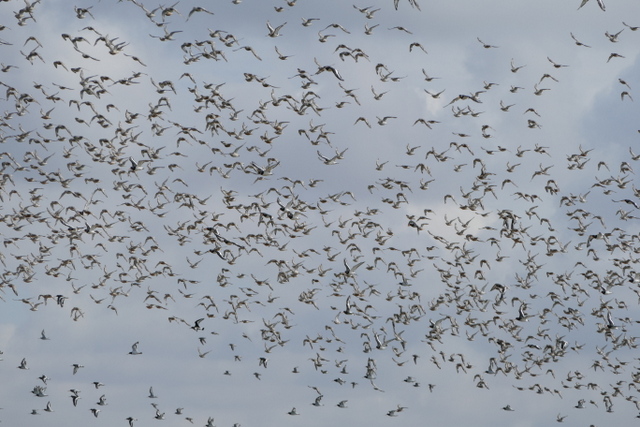 Waders – eventually the birds poured from the pits back to the Wash
Waders – eventually the birds poured from the pits back to the Wash
While the waders were all roosting on the pits, it gave us a chance to look at some of them up close, and to see some of the species which we had not spotted on the rising tide. There were several Little Stints in amongst the vast hordes of Dunlin and Knot, so small they can be hard to see in with their larger brethren. Fortunately, one came out to feed around the unoccupied island right in front of the hide. A Common Sandpiper also dropped in there to feed briefly.
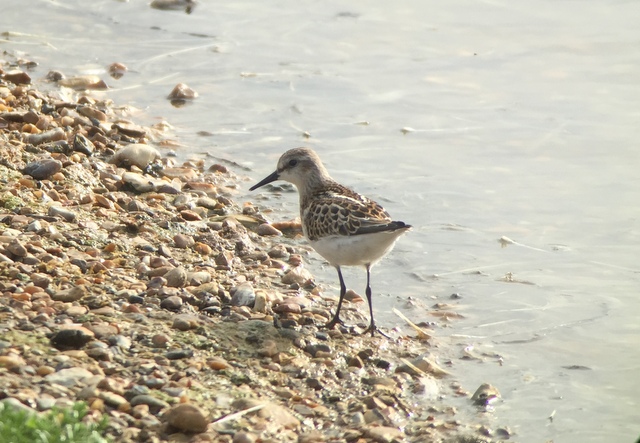 Little Stint – one of at least three on the pits over high tide today
Little Stint – one of at least three on the pits over high tide today
There are lots of Common Redshanks which feed out on the Wash and gather on the pits. Amongst them, we found some of their less common namesake. Spotted Redshanks are mostly a passage migrant here, but good numbers often pass through at this time of year. We could see at least 10 today, out on the pits. Most were adults in silvery grey and white winter plumage. A darker grey speckled juvenile Spotted Redshanks landed with Common Redshanks right in front of the hide today and we got a great view of its needle-fine bill and even the small downward kink it shows towards the end.
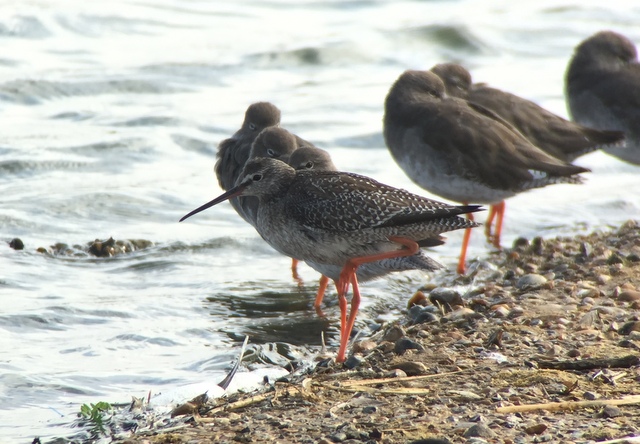 Spotted Redshank – sporting a needle-fine bill with slightly down-kinked tip
Spotted Redshank – sporting a needle-fine bill with slightly down-kinked tip
To complete the set of ‘shanks’, a couple of Greenshanks also came in to the island. One of them fed around the edge right below the hide. We got a great view of the green legs from which it gets its name.
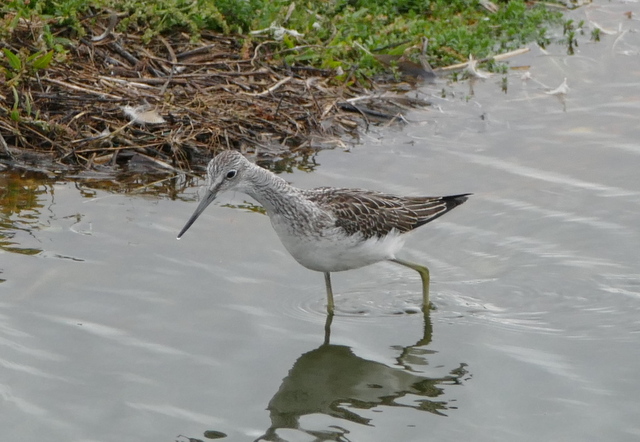 Greenshank – feeding below the hide
Greenshank – feeding below the hide
There were some other birds around the pits as well. A single Spoonbill was roosting amongst the Cormorants. It spent most of the time asleep, but did eventually wake up and flash its spoon-shaped bill. As well as the resident Egyptian Geese, the escapee Bar-headed Goose was on the pits again today.
 Spoonbill – roosting on the pits with the Cormorants
Spoonbill – roosting on the pits with the Cormorants
The Common Terns nesting on the islands still have chicks to raise – one of them still very small. We watched the adult birds returning repeatedly with fish for their young. A Kingfisher put in an all too brief appearance. It flew in and landed in the brambles right in front of the hide, on the edge of the water. The resulting excited shouts from the crown were probably too much for it and it promptly flew off again. We did get a great view of the Kingfisher later on – as the water started to recede out on the Wash, it flew past us and circled round right in front, catching the sun on its electric blue upperparts as it did so. What a beauty.
Out on the seawall, amongst the grass, were lots of Meadow Pipits and several Skylarks. Little groups of Linnets were feeding on the seed-bearing weedy growth. Several Pied Wagtails were flying back and forth along the beach on the edge of the Wash. We heard several Yellow Wagtails overhead, but it was only when we started to walk back that one appeared on the path in front of us.
With most of the waders having returned back out to the mud, we decided to move on. We drove back around the corner and up onto the North Norfolk coast, and headed for Titchwell. After an early lunch – well deserved after our early start – we headed out to explore the reserve.
After the recent rain, there was a bit of water on the grazing marsh pool which has been drained since the early winter. A single Greenshank was feeding on there today, along with several Lapwing. Further along, on the reedbed pool, was a selection of commoner ducks – including Gadwall, Pochard and Tufted Duck. We could hear Bearded Tits calling from the reeds, but couldn’t see them.
The water level on the freshmarsh was much higher as well, after the recent rain we have had. There was still a good selection of larger waders present, but numbers of the smaller species were much down on recent weeks. There were still lots of Ruff – adults in winter plumage with pale-scalloped grey upperparts and whiter underparts, and much browner but very variable juveniles.
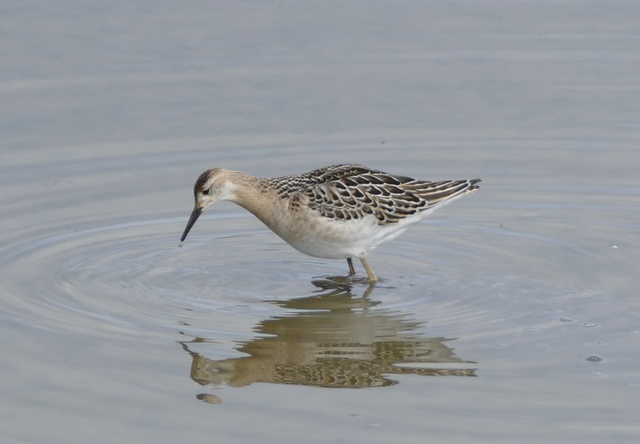 Ruff – a browner-toned juvenile
Ruff – a browner-toned juvenile
Numbers of Avocets are well down on the record counts of last month, but there is never a shortage of Avocets at Titchwell. It is always a delight to watch such stunning birds. There were also several Golden Plover out on the islands, some still sporting the remnants of summer plumage in the form of black bellies.
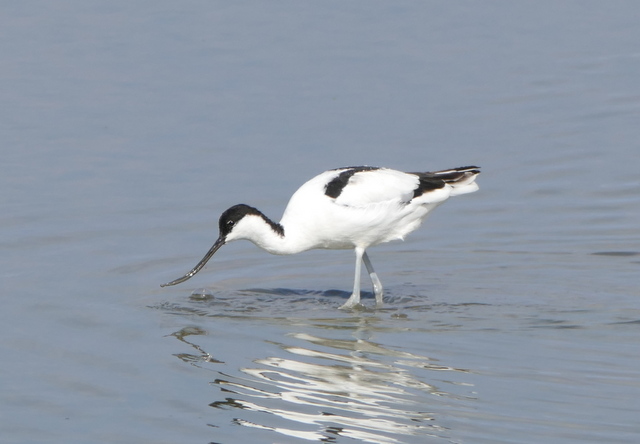 Avocet – feeding in the shallows in front of Island Hide
Avocet – feeding in the shallows in front of Island Hide
There were lots of gulls on the freshmarsh as usual today. The smaller ones were mostly Black-headed Gulls, but amongst them was a single Mediterranean Gull. An adult in winter plumage, we could see its white wing tips. There were also several Lesser Black-backed Gulls amongst the Herring Gulls.
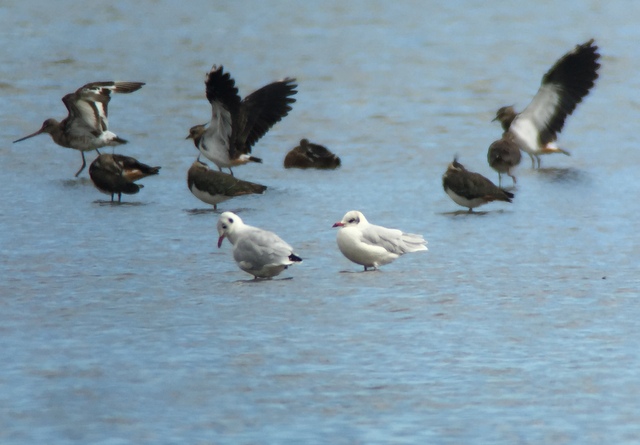 Mediterranean Gull – an adult with white wing tips next to a Black-headed Gull
Mediterranean Gull – an adult with white wing tips next to a Black-headed Gull
A brief shower passed over while we were in Island Hide and, when it brightened up again afterwards, we decided to make straight for the beach. There didn’t appear to be much on Volunteer Marsh at first – a distant Grey Plover and a Curlew or two. But as we got to the tidal channel on the far side, a scan revealed a single Whimbrel amongst more Black-tailed Godwits and Common Redshanks. We got the Whimbrel in the scope and could see its pale crown stripe.
 Black-tailed Godwit – feeding in the wet mud on the Volunteer Marsh
Black-tailed Godwit – feeding in the wet mud on the Volunteer Marsh
A Little Egret also seemed to have found a good place to feed. It was standing in the tidal channel, staring at the base of a waterfall as the remains of the morning’s high tide flowed off the marsh.
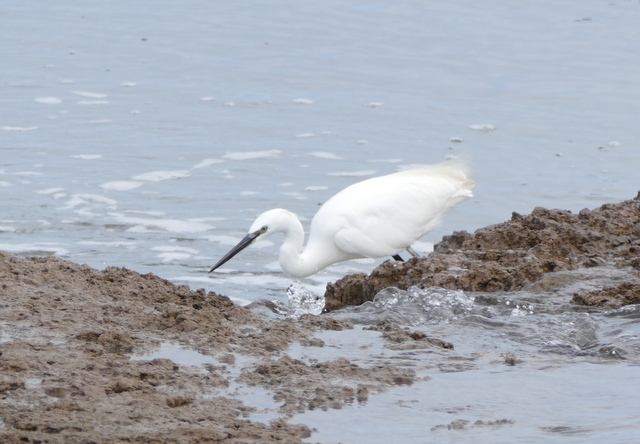 Little Egret – looking for food in the water flowing off Volunteer Marsh
Little Egret – looking for food in the water flowing off Volunteer Marsh
Out on the beach, there were not as many waders as usual. There were a couple of Bar-tailed Godwit and Turnstone on the rocks, plus a smart Grey Plover still mostly in summer plumage with black face and belly. Out on the sea, we could see a single Common Scoter. A Tufted Duck flew past out to sea. As did a single young Gannet.
We could see some very dark clouds coming in from the west, so we beat a hasty retreat back to Parrinder Hide and sat out the resulting shower. There was not much on this side of the freshmarsh which we hadn’t already seen on our way out. Three more Spotted Redshanks were preening right over towards the back corner. While we were scanning the marsh, suddenly everything took to the air in a panic. The culprit soon became apparent as a young Peregrine flew in from the direction of the sea. It made a couple of stoops – one at an unsuspecting Dunlin, which it missed, before flying off towards Thornham.
We did have time for one last surprise. Scanning the reeds at the far side of the freshmarsh, we picked up a couple of small tawny coloured shapes working their way along the base of the reeds. Finally, a couple of Bearded Tits. Unfortunately, they disappeared back into the reeds again fairly quickly.
Then it was time to head back – suitably tired after our early start this morning. But what a spectacle it had been!
